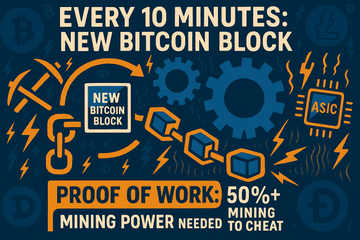Ever wondered why your mate’s Bitcoin wallet is so highly regarded, or what keeps the Bitcoin network ticking along without a central bank at the wheel? Here’s the thing: it's all thanks to Proof of Work (PoW). This magic ingredient sits at the core of many cryptocurrencies, including Bitcoin. PoW isn’t just some techie term thrown around at crypto meetups—it’s what makes your transactions trustworthy, secure, and even, believe it or not, a bit thrilling to those who get how it works.
So, What’s Proof of Work? Think of a High-Stakes Game of Sudoku
Imagine a global competition where folks across the world attempt to solve an almost impossible Sudoku puzzle, entirely for bragging rights and a tidy reward. That’s essentially what PoW is for the world of cryptocurrency. Thousands of computers, lovingly referred to as 'miners,' race to solve complex cryptographic puzzles. The first to crack it wins the right to add a new block—that is, a bundle of transactions—to the blockchain. This winner earns some new coins for their trouble. It’s a process that happens every ten minutes like clockwork in the Bitcoin universe.
Let Me Explain: How the Puzzle Keeps Crypto Honest
Here’s where it gets fascinating. Those puzzles are really hard to solve but laughably easy to check. Once a miner proposes a solution, the rest of the network can verify it almost instantly. If you’ve ever watched someone smugly show their completed crossword after you’ve sweated for an hour, you get the emotional vibe. Everyone else checks your work in a flash.
Because solving the puzzle takes so much computing power and electricity, it would be wildly expensive to cheat. This is where the magic of decentralization shines. No single person or group controls the process—every participant’s work is public and constantly double-checked. It’s sort of like a neighborhood potluck where everyone brings a dish, and no one wants to risk being the one who brings spoiled food. The community keeps itself honest.
Meet the Crypto Miners: The Backbone of PoW
You may have met those folks who talk endlessly about buying the latest ASIC miners or graphic cards—maybe even hoarding them like teenagers on launch day. Well, it’s no wonder. Mining is the big sporting event of crypto. The network sets a difficulty level, adjusting every couple of weeks, making sure a new block is solved roughly every ten minutes.
Miners invest serious money in hardware, cooling (seriously, it’s like a sauna in those mining warehouses), and power bills. They're all drawn by the chance to earn new coins, plus transaction fees—a bit like tipped waitstaff, if we’re being honest. Sometimes, they do all this and walk away empty-handed. That’s a risk you just have to wear in crypto mining.
Why All the Fuss About Security?
Here’s the simple reason: it’s incredibly, almost prohibitively, costly to cheat the system. To do so, you’d have to control over 50% of all mining power worldwide—a crazy expensive venture. This is what makes Bitcoin and its PoW siblings so robust. Even after years of hype, hacks, and big headlines, the core network remains untouched. PoW turns security into a team sport where everyone plays defense. The stronger the competition, the safer your coins are.
But Wait, Isn’t PoW Super Wasteful?
Now, let’s not gloss over the environmental side. PoW demands ridiculous amounts of electricity. Critics aren’t entirely wrong to question its energy use. Some say mining Bitcoin uses more energy than some small countries. Many folks are looking for greener alternatives and, honestly, it’s pushing the wider crypto world to consider new consensus models like Proof of Stake (PoS). But for die-hard security fans, PoW’s reliability makes it hard to leave behind.
Who’s Using Proof of Work Right Now?
- Bitcoin – The unstoppable granddad of crypto.
- Litecoin – Quicker block times, but same basic approach.
- Dogecoin – Yes, the meme that launched a thousand tweets.
These coins and a handful of others are still sticking with PoW. While Ethereum shook things up by switching to PoS, Bitcoiners remain loyal to the original grind. And, you know, if you ever stashed your coins in a hardware wallet like Trezor or Ledger, you’ve benefitted from the security these PoW-powered networks provide. These wallets don’t handle the mining themselves, but they guard your assets on these ultra-secure chains where PoW rules the roost.
PoW and the Human Element: Trust, Tenacity, and Just a Little Suspicion
There’s a wildly human story hiding in all this hardware and hashing. PoW reflects the old-school value of proving your worth by doing the work. It builds trust not by polite agreement, but by sacrificing resources. Want to cheat? You’ll have to back it up with real, hard cash and sweat equity. That resonates for a reason—it feels honest. And when someone promises something valuable (like your retirement fund locked up in Bitcoin), old-fashioned honesty goes a long way.
Trends: What's Changing in 2024?
So, where’s this all heading? In 2024, PoW is still vital. It's looked at with both admiration and criticism. Security remains nearly unbreakable, though the world is clearly searching for more efficient, less wasteful methods. Yet, even as newer coins lean towards PoS or other systems, PoW’s legacy and impact are undeniable. Discussions are swirling about hybrid approaches and community-driven solutions for greener mining. Who knows—maybe those warehouses will start popping up next to wind farms or in places with surplus hydroelectric energy. The world keeps turning, and so does PoW.
One Last Thought
Honestly, proof of work is like a group project where everyone pulls their weight because the reward is real, and there's nowhere to hide if you slack off. It’s messy, competitive, sometimes wasteful—but for the coins that rely on it, it’s the rock-solid foundation that keeps trust alive in a digital age. Next time someone shrugs about Bitcoin’s energy bill or gets emotional about decentralization, just remember the Sudoku puzzle, the sweat, and the security that keep the crypto heart beating.











